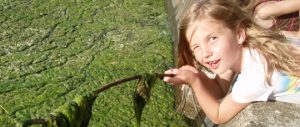There are plenty of sings that spring is in full force. Sometime these signs are natural indicators like flowers poking through weathered mulch, or migrating birds like sandhill cranes flying far overhead; but others, are signs of human life awakening after winter. These signs like people cleaning up boats, or washing cars and bikes in their drives, or the often dreaded spring clean-up around the yard – all can bring potential risks to local water quality.
As you are preparing your home and yard for spring, be sure to consider the impacts your lawn has on water quality. Your individual choices and actions make a difference!
- Follow the instructions on the bag and use only the right amount. More is not better! Any fertilizer that is not used by your lawn will end up in local stream or reservoir – growing potentially toxic algae and producing bad tasting water.
- If you use a lawn care company, make sure to talk to them about no-phosphorus fertilizer and minimum application rates throughout the season.
- If you are already using no-phosphorus fertilizer, or no fertilizer at all, or if you are asking your applicator to use no-P products, take the no-phosphorus pledge at www.ClearChoicesCleanWater.org.
Check it out to see how many people are on the map – take the pledge to show your support for healthy Indiana waters and get on the map yourself!
Your Yard Clean-up Choices
There are several natural ‘fertilizers’ and pollutants that accumulate over the winter, decompose, and find their way into the water as well. Things such as leaf litter, pet waste, and general landscaping yard waste all contain nutrients such as phosphorus that can also add to spring and summer algal blooms.
- Please bag or compost leaves – do not rake leaves or other yard waste like last year’s flower stalks or grass clippings, etc. into the ponds or streams or storm drains!
- Pick up and dispose of pet waste in the garbage!
Even some other simple spring-cleaning backyard behaviors like car or boat washing and oil changes can also be a significant source of nutrients and other pollutants to the local streams and drinking water supplies.
- Used oil from a single oil change can pollute up to 1,000,000 gallons of freshwater.
- In order for one ounce of biodegradable detergent to be safe for fish, it needs to be diluted by almost 20,000 ounces of water.
These pollutants get to the reservoir through direct runoff from yards or street-side storm drain inlets that discharge untreated to nearby streams or to the reservoir itself.
Consider the choices you are making around your home as you begin spring yard work. Protecting the water quality of Morse Reservoir requires everyone to do their part to make sure their property doesn’t contribute pollution to our water supplies. You can make a difference – make a clear choice for clean water!


Recent Comments